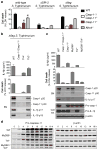Caspase-11 increases susceptibility to Salmonella infection in the absence of caspase-1
- PMID: 22895188
- PMCID: PMC3470772
- DOI: 10.1038/nature11419
Caspase-11 increases susceptibility to Salmonella infection in the absence of caspase-1
Abstract
Inflammasomes are cytosolic multiprotein complexes assembled by intracellular nucleotide-binding oligomerization domain (NOD)-like receptors (NLRs) and they initiate innate immune responses to invading pathogens and danger signals by activating caspase-1 (ref. 1). Caspase-1 activation leads to the maturation and release of the pro-inflammatory cytokines interleukin (IL)-1β and IL-18, as well as lytic inflammatory cell death known as pyroptosis. Recently, a new non-canonical inflammasome was described that activates caspase-11, a pro-inflammatory caspase required for lipopolysaccharide-induced lethality. This study also highlighted that previously generated caspase-1 knockout mice lack a functional allele of Casp11 (also known as Casp4), making them functionally Casp1 Casp11 double knockouts. Previous studies have shown that these mice are more susceptible to infections with microbial pathogens, including the bacterial pathogen Salmonella enterica serovar Typhimurium (S. typhimurium), but the individual contributions of caspase-1 and caspase-11 to this phenotype are not known. Here we show that non-canonical caspase-11 activation contributes to macrophage death during S. typhimurium infection. Toll-like receptor 4 (TLR4)-dependent and TIR-domain-containing adaptor-inducing interferon-β (TRIF)-dependent interferon-β production is crucial for caspase-11 activation in macrophages, but is only partially required for pro-caspase-11 expression, consistent with the existence of an interferon-inducible activator of caspase-11. Furthermore, Casp1(-/-) mice were significantly more susceptible to infection with S. typhimurium than mice lacking both pro-inflammatory caspases (Casp1(-/-) Casp11(-/-)). This phenotype was accompanied by higher bacterial counts, the formation of extracellular bacterial microcolonies in the infected tissue and a defect in neutrophil-mediated clearance. These results indicate that caspase-11-dependent cell death is detrimental to the host in the absence of caspase-1-mediated innate immunity, resulting in extracellular replication of a facultative intracellular bacterial pathogen.
Figures



References
-
- Wang S, et al. Identification and characterization of Ich-3, a member of the interleukin-1beta converting enzyme (ICE)/Ced-3 family and an upstream regulator of ICE. J Biol Chem. 1996;271:20580–20587. - PubMed
Publication types
MeSH terms
Substances
Grants and funding
LinkOut - more resources
Full Text Sources
Other Literature Sources
Molecular Biology Databases
Miscellaneous

